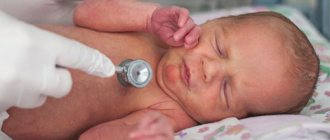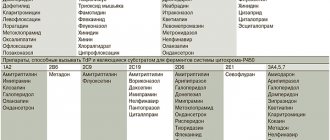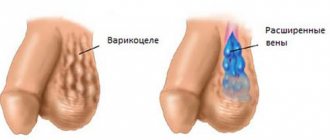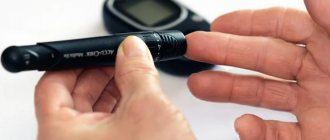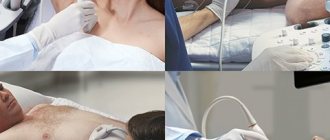Accelerated metabolism and increased oxygen demands cause children's hearts to beat faster. Heart rate norms are individual for each age. If for some reason this indicator exceeds the norm for no apparent reason (emotional experiences or physical exertion, overheating), tachycardia is diagnosed. At the medical center (Moscow, Otradnoye metro station, North-East Administrative District), cardiologists diagnose and treat tachycardia in children. Therapy begins with eliminating the root cause, and along the way, doctors select medications that alleviate the condition.
Causes and types
Restlessness is considered one of the causes of cardiac tachycardia in childhood. Children are constantly moving, which naturally causes an increase in heart rate and heart rate. Other factors are also possible:
- dehydration;
- heart murmurs;
- anemia;
- cardiopathy;
- thyrotoxicosis;
- Congenital heart defect.
In addition, there are two forms of the disease: sinus and paroxysmal, which also develop for certain reasons. Sinus tachycardia in children is a consequence of:
- accelerated growth;
- stress;
- disorders of the endocrine or cardiovascular systems;
- overwork.
Diagnosing the cause of the paroxysmal form is more difficult, since in this case the heart rate increases and slows down suddenly. Seizures occur at any age, including in newborns.
Characteristic manifestations of paroxysmal tachycardia
The attack begins and ends unexpectedly and can last from several minutes to 2 days. The first sign of the disease is felt as a sharp “push” in the heart, and then the pulse quickens to 140-200 beats per minute and remains this way for several minutes or even days.
In addition, the disease is manifested by the following symptoms:
- noise in the ears and head;
- nausea or vomiting;
- dizziness and headaches;
- flatulence;
- feeling as if the heart muscle turns to stone and contracts;
- excessive sweating.
Ventricular tachycardia is manifested by an increase in heart rate up to 180 beats per minute, and supraventricular tachycardia - from 180 to 250 beats per minute.
If the attack lasts for a long time, the patient may experience a drop in blood pressure, fainting, and severe weakness. After its completion, a person may experience excessive urine output.
Symptoms
In addition to palpitations, cardiac tachycardia in children manifests itself:
- chest pain;
- shortness of breath;
- dizziness and fainting;
- lethargy and pallor;
- nausea;
- sweating
At such moments, infants become restless and capricious, refusing to eat and sleep. It is important to consult a doctor as soon as you notice the first signs of illness. If tachycardia in children is not treated, the severe pathologies that caused it will lead to serious complications:
- arrhythmogenic shock;
- pulmonary edema;
- heart failure;
- cardiac arrest.
emergency care for paroxysmal tachycardia
Emergency care for paroxysmal tachycardia
Supraventricular tachycardia.
QRS duration is normal or less than 0.08 seconds. Techniques of vagal irritation or vagotonic reflex tests are used only for supraventricular paroxysmal tachycardia with normal QRS complexes. They are not used in young children and are most effective in the first 20 minutes after an attack. It is preferable to prescribe to children over 3 years of age.
If reflex methods are ineffective (if the child’s condition does not require extreme measures), for children over 3 years of age: crushed and in a sufficient amount of liquid, seduxen 1\3-1 tablet, isoptin 1\3-1 tablet. (1 mg/kg) and 1-2 tablets. panagin, after an hour can be repeated in the same doses. The child can be put to bed, creating a calm environment (protective mode).
It is possible to combine verapamil (1-2 mg/kg) and the beta-blocker pindolol (0.25 mg/kg) in the form of crushed tablets. The effect is observed on average after 10 minutes in 75% of patients, and the drugs are well tolerated.
Propranolol can be administered orally in a single dose of 1 mg/kg in 3 doses with an interval of 2 hours. But it is more advisable to use propranolol (1-2 mg/kg) and diltiazem (voltage-dependent calcium channel blocker) (1-2 mg/kg), which first reduce the severity of tachycardia, and then, on average, stop the attack after 30-40 minutes.
Pindolol - indications are the same as propranalol, if administered 0.1-0.2 mg/kg/day slowly.
If there is no positive dynamics or the child’s clinical condition worsens, as well as in young children, it is necessary to start with intravenous administration.
1. Isoptin (verapamil) 2.5% - 0.1-0.2 mg/kg IV in 20 ml of 10% glucose solution in combination with seduxen and 2-5 ml of panangin. Since the effect is short-term (40-60 minutes), if there is no effect, repeat after 30 minutes. Can be combined with sibazon and 2-5 ml of panagin.
2. Adenosine monophosphate (AMP) or phosphadene 2% solution 0.1 mg/kg for a very fast bolus (2-3 sec), diluted with saline to avoid sequestration of adenosine in red blood cells. The dose can be doubled and repeated again until the attack stops or side effects appear (redness, shortness of breath, chest pain, bradycardia, irritability, but usually disappear within 1-2 minutes). The maximum single dose should not exceed 12 mg or 0.3 mg/kg. Can be used for all types of tachyarrhythmias. It has a direct inhibitory effect on the AV node.
3. ATP (phosphobion ) up to 6 months 0.5 ml, 6-1 years -0.7 ml, 1-3 years -0.8, 4-7 years -1.0, 8-10 years 1.5 ml, 11-14-2.0 ml. administer without dilution quickly (2-3 seconds). Similar action with adenosine.
4. Procainomide (novocainomide) – used in the absence of heart failure, arterial hypotension, blockades, and simultaneous use of digoxin. 10% -5.0 -0.15-0.2 ml/kg IV together with 1% mesaton solution - 0.1 ml/year of life (to prevent a sharp drop in blood pressure, especially against the background of heart failure. It also inhibits antegrade conduction in the AV node ).
5.0.1% solution of anaprilin (obzidan), propranolol - 0.01-0.02 mg/kg, very slowly in a stream.
6. Ajmaline (gilurythmal) iv slowly 2.5% single dose 1 mg/kg in 20 ml of saline solution.
7. If other drugs are ineffective, a 5% solution of cardarone (amiodarone) 5 mg/kg or 0.1 ml/kg in 150 ml of a 5% glucose solution blocks K channels, to a lesser extent Ca channels, inhibits a and b receptors.
Ventricular tachycardia.
Ventricular QRS is wide for ages greater than 0.08 sec.
1. Lidocaine 1% - 1 mg/kg IV for 2 minutes, if there is no effect, can be repeated after 5-10 minutes. Then 2 mg/min intravenously in the first 12 hours, then 1 mg/min for 12 hours. The second drug is procainomide, which is administered intravenously as a bolus of 100 mg every 5 minutes until the gastrointestinal tract is eliminated or a total dose of 10-20 mg/kg is achieved. Monitoring blood pressure and ECG. Then administer 2 mg/min intravenously over several hours.
2. If there is no effect: novocainomide (procainomide) 10% - 5.0 -0.15-0.2 ml / kg IV in a slow stream along with a 1% solution of mezaton - 0.1 ml / year of life (to prevent a sharp drop in blood pressure, especially against the background of heart failure. It also inhibits antegrade conduction in the AV node).
3. If the first two are ineffective - Ornid (bretylium tosylate) - sympatholytic -5% -1.0 - 5-10 mg/kg. in 50 ml of 5% glucose for 20 minutes.
4. If malignant gastric tract is resistant to other drugs, a 5% solution of cardarone (amiodarone) 5 mg/kg or 0.1 ml/kg in 150 ml of 5% glucose solution is indicated - it blocks K channels, to a lesser extent Ca channels, inhibits a and b receptors.
5.0.1% solution of anaprilin (obzidan), propranolol - 0.01-0.02 mg/kg, very slowly in a stream. If the attack does not stop for a long time (more than 24 hours), signs of circulatory failure increase, the neck veins swell, pallor and cyanosis increase, then defibrillation is indicated. Carrying out cardioversion (a method of treating tachyarrhythmias using a defibrillator). When paroxysmal tachycardia is combined with heart failure, IV digoxin 0.025% -0.03-0.05 mg/kg/day for 3 injections - rapid saturation. Half the daily dose in the first administration. Digoxin is combined with the administration of propronalol and verapamil, but propronalol and verapamil should not be given together due to a sharp drop in blood pressure and the risk of cardiac arrest.
Diagnostics
The task of a cardiologist who examines a child with suspected tachycardia is to make sure that the signs he has do not indicate other diseases, for example, bronchial asthma. Also during the examination, he looks for the cause of the disease. To do this, the specialist uses:
- ECG and daily monitoring to analyze how the heart rhythm changes during the normal activity of a small patient;
- EchoCG and MRI to make sure there are no heart pathologies;
- an electrophysiological study to check how the electrical impulse travels through the heart muscle;
- laboratory methods: urine, blood analysis;
- EEG of the brain to make sure that the activity of the central nervous system is not impaired.
Diet food
When paroxysmal tachycardia is diagnosed, the patient needs to constantly monitor blood sugar and cholesterol levels. Gaining excess weight is not allowed. Overeating can trigger the onset of an attack of tachycardia. Therefore, it is important to eat small portions 4-5 times a day.
The last meal should be no later than 2 hours before going to bed. It is important to exclude “provoking” foods and drinks:
- coffee Tea;
- confectionery sweets and buns;
- foods containing a lot of sugar and starch;
- butter, lard and mayonnaise.
Treatment and prognosis
In case of sudden attacks of tachycardia, the child should be taken out into the fresh air, tight clothes should be removed, a damp handkerchief should be placed on the forehead, and then a doctor should be called. If there is no pathology, and hormonal changes and stress lead to an acceleration of the heart rate, to treat tachycardia in children, the cardiologist will prescribe drug therapy (beta-blockers, cardiac glycosides, calcium antagonists, sedatives). Auxiliary measures: physical therapy, valgus techniques. To alleviate the condition, a diet is recommended in which it is undesirable to consume chocolate, tea, spicy, and salty foods.
Children who follow the doctor's recommendations usually return to their previous lives and activities. In rare cases, when the disease develops due to other serious pathologies that cannot be treated conservatively, surgery is prescribed.
Treatment
The choice of treatment depends on the form and type of disease. The next attack requires immediate hospitalization. The patient is admitted to the cardiology department if there are noticeable attacks more than 2-3 times a month.
The exception is short-term attacks with a smooth course that do not cause complications. In this case, the doctor may administer an antiarrhythmic drug intravenously (Propranolol, Quinidine, Cordarone). If the attack does not stop, then electrical impulse therapy may be prescribed.
An experienced doctor can stop paroxysm of tachycardia. A mechanical method of influencing the vagus nerve is used. For example, the following methods are used:
- applying gentle pressure on the upper corner of the eyeball from the inside;
- straining;
- inducing the gag reflex by irritating the root of the tongue;
- Pinch your nose and mouth and exhale forcefully in this state.
If an attack of tachycardia occurs several times a month, then the doctor may prescribe the following drugs to reduce the risk of relapse: Celanide, Kinylentin, Verapomil.
In particularly severe cases, doctors resort to surgical intervention:
- installation of a pacemaker;
- destruction of the impulse pathways and the source of tachycardia by mechanical, laser or electrical action;
- using an electric defibrillator.
Paroxysmal tachycardia: danger and risk groups
Paroxysmal tachycardia has a negative impact on human health. This is expressed as follows:
- “wear and tear” of the heart muscle;
- cardiogenic shock;
- the efficiency of the circulatory system decreases;
- development of heart failure;
- pulmonary edema.
A recurrent form of the disease can trigger the occurrence of arrhythmogenic cardiomyopathy. In especially severe cases, the disease can cause clinical death and death.
Most often, paroxysmal tachycardia affects older people with a history of heart attack, myocardial disease, coronary heart disease and those with hypertension or heart disease.
